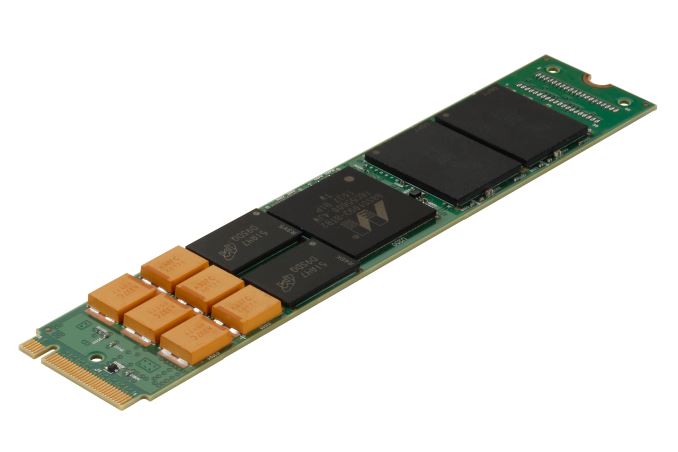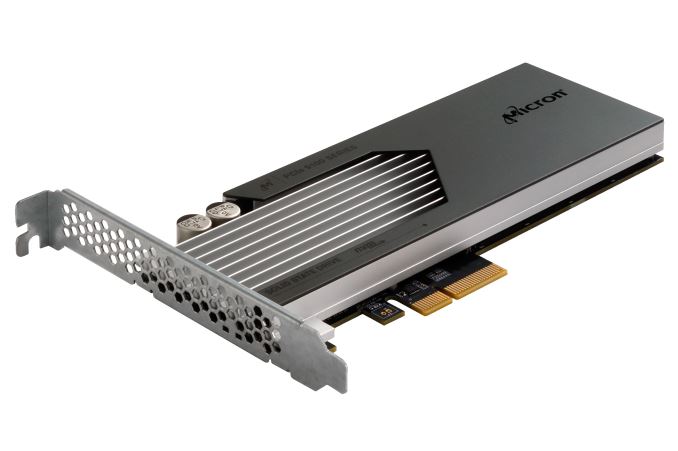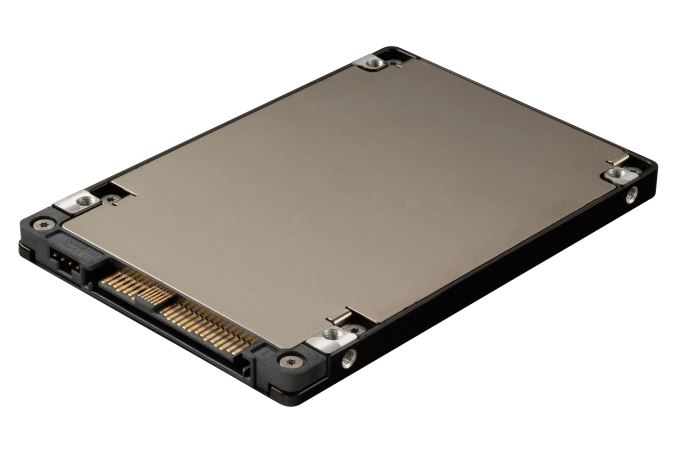Micron Announces 9100 & 7100 Series PCIe Enterprise SSDs
by Billy Tallis on April 12, 2016 11:30 AM EST- Posted in
- SSDs
- Storage
- Micron
- Enterprise SSDs
- NVMe

Micron entered the PCIe SSD market in 2011 with the formidable P320h. Using generously overprovisioned 34nm SLC NAND and a controller with 32 NAND channels and a PCIe 2.0 x8 link, the P320h boasted extreme write endurance ratings and performance that is still respectable by today's standards, but with a commensurate price tag. Two years later Micron introduced the P420m with the same controller but 25nm MLC NAND, adding power loss protection capacitors and offering similar performance on read-heavy workloads at a much more accessible price. Today Micron is announcing two new product lines that bring support for NVMe and PCIe 3.0 and use Micron's latest 16nm MLC NAND.
The new Micron 9100 NVMe PCIe SSD series is the high-performance and high-capacity product. Capacity ranges from 800GB to 3.2TB in either half-height half-length add-in card form factor or as a 15mm thick 2.5" U.2 drive. With a TDP of up to 27W, the Micron 9100 SSD is the more direct successor to the P420m and is using a PMC-Sierra controller that is descended from the controller used in Micron's previous PCIe SSDs.
| Micron 9100 PCIe SSD Specifications | |||||
| Capacity | 800GB | 1.2TB | 1.6TB | 2.4TB | 3.2TB |
| Interface | PCIe 3.0 x4 HHHL or U.2 | ||||
| Sequential Read | 2.1 GB/s | 2.8 GB/s | 2.8 GB/s | 3.0 GB/s | 3.0 GB/s |
| Sequential Write | 650 MB/s | 1.3 GB/s | 1.3 GB/s | 2.0 GB/s | 2.0 GB/s |
| Random Read IOPS | 540k | 700k | 700k | 750k | 750k |
| Random Write IOPS | 55k | 180k | 100k | 300k | 160k |
| Idle Power Consumption | 7W | ||||
| Active Power Consumption | 16W | 21W | 21W | 27W | 27W |
The Micron 7100 NVMe PCIe SSD expands Micron's offerings into a more mainstream segment of the market by adopting Marvell's 88SS1093 controller that is designed for client and smaller enterprise drives. Capacities for the 7100 range from 400GB to 960GB for the M.2 version and from 400GB to 1.9TB as a 7.5mm thick 2.5" U.2 drive. The smaller Marvell controller will keep power consumption below 12.5W and the M.2 version further throttles to a limit of 8.25W.
| Micron 7100 PCIe SSD Specifications | ||||||
| Capacity | 400GB | 480GB | 800GB | 960GB | 1.6TB | 1.92TB |
| Interface | M.2 22110 or 2.5" U.2 | 2.5" U.2 | ||||
| Sequential Read | 2.4 GB/s | 2.5 GB/s | 2.5 GB/s | |||
| Sequential Write | 475 MB/s (M.2) 500 MB/s (U.2) |
600 MB/s (M.2) 900 MB/s (U.2) |
900 MB/s | |||
| Random Read IOPS | 180k | 220k | 235k | |||
| Random Write IOPS | 25k | 10k | 33k | 12k | 40k | 15k |
| Idle Power Consumption | 3.7W | |||||
| Maximum Power Consumption | 8.25W (M.2) 12.5W (U.2) |
12.5W | ||||
Both the 9100 and 7100 series include models in two tiers of overprovisioning: for read-heavy or mixed workloads. The drives with greater overprivisioning sacrifice some capacity for greatly increased random write speeds and improved write endurance, though specifications for the latter have not yet been released.
Source: Micron












21 Comments
View All Comments
ImSpartacus - Tuesday, April 12, 2016 - link
What are those yellow things on the first pictured ssd. Are those like capacitors or something?questionlp - Tuesday, April 12, 2016 - link
Correct, "power loss protection capacitors".ddriver - Tuesday, April 12, 2016 - link
Considering those capacitors cost less than 1$, one is inclined to ask why are such not found in consumer products, they would barely add to the BOM.QinX - Tuesday, April 12, 2016 - link
Because you're controller also needs to be able to handle it. It has to detect the loss of power and be able to write the cache to the NAND before the capacitors are drained. This tech might not be present in every controller. You would also need some other components and PCB traces to achieve it. it might be only a $10 BOM increase but by the time it reaches e-tailers you might be talking about a $40 markupddriver - Tuesday, April 12, 2016 - link
Can you substantiate that claim? Every general purpose microcontroller can be programmed to do that, so it shouldn't be a problem for a dedicated chip. Could it be that the industry doesn't care about the optimal price to feature ration, and is only diligent when it comes to high margin products? It certainly would not be the first time something like that happens.Just the other I had a capacitor blow up, ruining a 400$ machine. The capacitor was rated at 240 volts and was running 220 volts, which is known to fluctuate at least a good 10%. The capacitor was essentially a time bomb. The same capacitor rated at 400 volts costs only 1 cent more, and would have lasted much longer, but they didn't go for it.
jordanclock - Tuesday, April 12, 2016 - link
Because they're charging for engineering and for the value of such a feature. The BOM cost has little to do with the retail price of any device these days.Samus - Wednesday, April 13, 2016 - link
For the same reason we don't have ECC memory in our desktops and laptops: it isn't necessary. Power loss protection capacitors are a novelty. Since most consumer SSD's spend 99.9% of their time at idle, in the event of a system crash or power outage, a chkdsk will resolve any file system errors that would have occurred during the in flight dump the drive did before power failure (crucial MX series based on Marvell controllers) or in the case of most other SSD's there wouldn't be anything in flight because no user data is cached to DRAM. Many SSD's now don't even HAVE a DRAM buffer!Caps are only necessary on drives that are caching user data off-NAND, use the NAND as a write buffer, or are in a high-write environment such as databases. Everyone else gets by without it. I love the idea of them, and I've never seen an SSD320 or my own SSD730 become corrupt during a power outage (and my SSD730, against Intel's recommendation, is in my laptop :) but at the end of the day it's inconclusive if capacitors actually matter for a consumer application, which is why they are rarely ever offered in one. DRAM often just caches the indirection table, every time it's changed, the changes are updated to the copy in NAND and if the power fails DURING that copy, the previous copy of the indirection table, also in NAND, is kept as a backup because that backup isn't deleted until the copy from DRAM to NAND is marked complete and passes verification. Drives that don't have DRAM are virtually immune to indirection table corruption, they're just slower because they access it and update it in NAND so IOPS suffer while that traffic causes overhead, bogging down data traffic.
Samus - Wednesday, April 13, 2016 - link
*Meant to say uses DRAM as a write buffer, not NANDddriver - Wednesday, April 13, 2016 - link
Capacitors - novelty? LOL. Together with hot water and sliced bread...jordanclock - Wednesday, April 13, 2016 - link
These are enterprise SSDs and power loss capacitors are FAR from a novelty in that arena. I'm not sure why you keep talking about consumer applications for enterprise SSDs. You made a lot of unsubstantiated claims and threw out some anecdotes, but you might as well have been talking about a completely different subject.